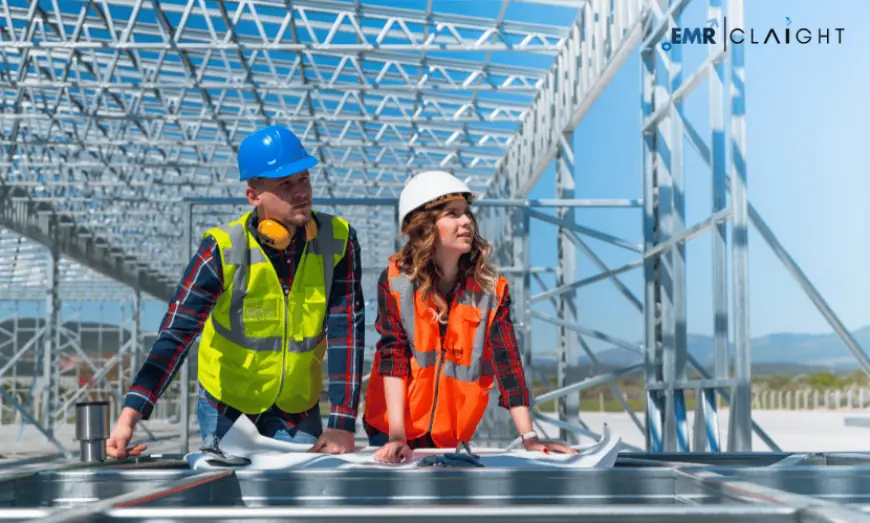Australia Construction Market Size & Outlook | Forecast 2034
The Australia construction market is driven by urbanization, infrastructure projects, and residential developments. Government investments in transport, energy, and commercial spaces further support industry growth.

The Australia construction market plays a vital role in shaping the country’s infrastructure and economic progress. It is a key contributor to Australia’s GDP and a major source of employment across both urban and regional areas. The market includes residential, commercial, industrial, and infrastructure development projects that cater to a growing population and evolving economic demands. The sector has been witnessing increased investment due to the rising need for housing, transport networks, energy facilities, and public amenities. Government support for urban renewal, along with favourable lending rates and economic recovery strategies, has made the construction industry a focal point for national development. Importantly, the adoption of innovative construction technologies, such as prefabrication, 3D printing, and smart building systems, has helped reduce costs, improve efficiency, and speed up project timelines, further fuelling the industry’s expansion.
Australia Construction Market Size
In 2024, the Australia construction market was valued at approximately AUD 423.38 billion. This value encompasses diverse segments, including residential housing, commercial buildings, infrastructure projects, and industrial facilities. The size of the market reflects the country’s ongoing infrastructure renewal programs, urbanisation trends, and housing demands in major cities such as Sydney, Melbourne, Brisbane, and Perth. Both public and private investments continue to drive large-scale developments, including transport corridors, hospitals, schools, and smart city projects. The sizeable valuation also demonstrates Australia’s strong project pipeline and the commitment of various stakeholders towards building a sustainable and modern built environment.
Australia Construction Market Growth
The Australia construction market is expected to grow at a compound annual growth rate (CAGR) of 4.00% from 2025 to 2034. The market is projected to reach approximately AUD 626.71 billion by the end of this period. This steady growth is attributed to multiple factors, including ongoing demand for affordable housing, transport infrastructure upgrades, and government-backed construction stimulus measures. Technological innovations are significantly contributing to the sector’s efficiency and sustainability, making it easier for developers and contractors to complete projects on time and within budget. Additionally, population growth and increased urban migration are creating a continuous need for new homes, roads, railways, and commercial spaces, all of which support long-term growth.
Australia Construction Market Trends
Several key trends are shaping the Australia construction market. A major trend is the integration of digital technology into construction workflows. Building Information Modelling (BIM), drone surveillance, and construction management software are helping improve project planning, monitoring, and quality assurance. Green construction is another growing trend, with developers incorporating energy-efficient designs and sustainable building materials to reduce the environmental footprint of new projects.
Prefabricated and modular construction is also gaining popularity due to its potential to reduce labour costs and construction timelines. The use of robotics and automation in construction tasks is beginning to emerge, particularly in large-scale commercial developments and infrastructure projects.
There is also a strong emphasis on workforce training and safety compliance. With the introduction of new technologies, the industry is placing greater focus on upskilling construction workers and ensuring safer, more productive work environments.
Industry Segmentation
The market can be segmented based on material type, end use, region.
Market Breakup by Material Type
- Concrete
- Steel
- Wood
- Others
Market Breakup by End Use
- Residential
- Commercial
- Infrastructure
- Industrial
Market Breakup by Region
- New South Wales
- Victoria
- Queensland
- Australian Capital Territory
- Western Australia
- Others
Market Opportunities and Challenges
Opportunities:
- Growing demand for smart and green buildings in urban areas
- Increased government funding for transport and social infrastructure
- Expanding use of digital construction technologies for better project outcomes
- Job creation and skill development programs supporting workforce expansion
- Development of regional areas through improved infrastructure and housing
Challenges:
- Rising material costs and supply chain disruptions affecting project budgets
- Labour shortages in specialised construction fields
- Regulatory and zoning restrictions delaying project approvals
- Environmental and community concerns over large-scale developments
- Dependence on foreign investment for major commercial projects
Australia Construction Market Analysis
The Australia construction market consists of various segments, including residential, non-residential, and infrastructure developments. The residential sector continues to dominate due to ongoing demand for housing driven by population growth and changing household dynamics. High-rise apartments, townhouses, and sustainable residential communities are in high demand in capital cities.
Non-residential construction, which includes commercial office spaces, retail developments, and educational institutions, is expanding as businesses recover and adapt post-pandemic. Infrastructure construction is seeing a robust pipeline of projects, including roads, railways, airports, and energy facilities, supported by both state and federal government funding initiatives.
Major industry players are actively investing in innovation and technology to remain competitive. Collaborations between construction firms, technology providers, and government bodies are improving project delivery and safety outcomes. The sector also benefits from partnerships with international investors and developers, bringing global expertise and capital into Australia’s construction ecosystem.
Furthermore, sustainability is becoming a core focus, with new buildings aiming for green certifications such as NABERS and Green Star ratings. The use of environmentally friendly construction materials and energy-efficient technologies is influencing design and development choices.
Overall, the Australia construction market is dynamic and forward-looking, with a solid foundation for future growth driven by innovation, strong demand, and supportive policy frameworks.
Competitive Landscape
The key players in the industry includes:
- CPB Contractors
- Lendlease
- Laing O’Rourke
- John Holland
- Fulton Hogan
- Bouygues Construction
- CIMIC Group
- BESIX Watpac
- Grocon
- Hutchinson Builders
- Others
Media Contact
Company Name: Claight Corporation | Expert Market Research
Contact Person: John Walker, Corporate Sales Specialist – Australia
Email: sales@expertmarketresearch.com.au
Toll Free Number: +61 448 06 17 27 | +1-415-325-5166
Address: 63 Fiona Drive, Tamworth, NSW, Australia
Website: https://www.expertmarketresearch.com.au
What's Your Reaction?
 Like
0
Like
0
 Dislike
0
Dislike
0
 Love
0
Love
0
 Funny
0
Funny
0
 Angry
0
Angry
0
 Sad
0
Sad
0
 Wow
0
Wow
0















































